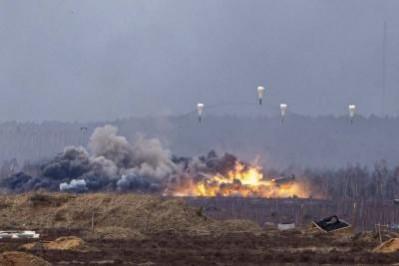
On July 16, 2025, Ukraine faced an unprecedented night of terror from the skies. Over 490 drones and cruise missiles stormed its critical infrastructure in the span of 13 hours. Defense systems intercepted 277 UAVs and 19 missiles, but dozens still reached their targets. Cities plunged into darkness, civilians injured, and strategic assets hit well behind the frontlines confirmed what military analysts had forecast: drones are no longer supporting assets they are the main characters in the story of modern war.
This concentrated attack, the latest in a series of surging drone campaigns, represents not just strategic escalation but a new complexion of conflict, driven by machine coordination, algorithmic targeting, and unlimited affordability.
"Drones are no longer tactical tools. They are strategic disruptors, economic equalizers, and instruments of deterrence and destruction."— Kateryna Stepanenko, European Policy Analysis Center.
The Age of the Drone: Platforms and Classes
Today's battlefield drones fall under several key categories, each designed for different operational roles and geographies:
1. Reconnaissance and ISR Drones (Intelligence, Surveillance, Reconnaissance):
Used for real-time situational awareness, observation, and artillery correction, these include low-altitude quadcopters like DJI Mavic, mid-tier systems like the ScanEagle, and high-end assets such as Heron TP and the MQ-9 Reaper. They typically feature EO/IR payloads, secure uplinks, and high-endurance engines.
2. Combat and Strike UAVs (UCAVs):
Armed drones, including Bayraktar TB2, Wing Loong II, MQ-9B, and Russia's Orion-E, carry laser-guided missiles (e.g., MAM-L, Hellfire), loitering air-to-ground munitions, and sometimes even anti-radiation capabilities. These platforms offer medium- to high-altitude, long-endurance strike power at a fraction of conventional sortie costs.
3. Loitering Munitions ("Kamikaze Drones"):
Also known as "suicide drones," these are built with explosive payloads and GPS/EO targeting to dive into targets. Switchblade 300/600, Hero-120, and Shahed-136 exemplify this group. Ukraine's FPV drones operate in this class, able to destroy tanks and artillery for as little as $500 per unit.
4. Swarm Drones:
Typically comprised of dozens to hundreds of small, AI-coordinated drones working together to confuse, disable, or overwhelm defenses. Both Ukraine and Russia, as well as China and the U.S., are advancing battlefield-ready swarm programs with lethal and non-lethal functions.
5. Ground and Maritime Drones:
UGVs (unmanned ground vehicles) now deliver supplies, evacuate wounded soldiers, and operate as mobile IEDs. USVs (unmanned surface vessels), notably Ukraine's Sea Baby and Magura V5, are now used to disrupt naval logistics and force navies from contested waters.
"Swarms are deadlier than a sniper, cheaper than a smartphone, and as scalable as the cloud."—StartUs Insights, 2025 Military Tech Report.
The Multi-Domain Transformation in Ukraine
Ukraine has become the world's most advanced drone warfare laboratory not by choice, but by necessity. Facing a larger and heavily armed adversary, it has built a distributed network of drone manufacturers, battlefield coders, and operational units.

Using thousands of First-Person View (FPV) kamikaze drones per month, Ukrainian forces deploy UAVs as flying snipers with commercial parts and custom explosives. These drones cost $400 to $2,000 but routinely destroy targets worth $1 million or more. In 2025's "Operation Spiderweb," they destroyed or disabled more than 40 Russian aircraft at rear bases, including a third of Russia's cruise missile-capable bombers.
Ukraine now integrates aerial, ground, and naval drones into layered attacks, sometimes launched in coordinated waves with over 100 assets. AI support allows Ukrainian teams to map movements, designate targets, and execute autonomous or semi-autonomous missions from hundreds of kilometers away.
Russia's Drone Surge: Attrition Meets Adaptation
Russia's drone campaign has scaled aggressively. In the first half of 2025, it averaged 3,500 drone strikes per month, a threefold increase from 2024. Over 7,900 drones were launched between March and May; though more than 4,100 were intercepted, *999 hit their targets*, and the rest lost to technical faults or jamming.
Upgraded Shahed drones now carry 90 kg payloads with fragmentation warheads designed explicitly for civilian impact. While Ukraine's air defenses have progressed, even a 20 percent penetration rate means dozens of successful strikes per day.
"The pace and scale at which drones pinpoint, fix, and finish targets is rendering traditional military formations outdated." — Brigadier General (Ret.) Mark Montgomery, US Cyberspace Command.
Global Drone War: Strategy, Trends, and Lessons
Drones are no longer limited to European theaters. In the Middle East, drone attacks by state-backed militias have struck oilfields in Kurdistan and tankers in the Red Sea. In Myanmar, rebels have conducted over 2,100 drone-based attacks since 2022. In Africa, commercial quadcopters are now anti-ambush tools and urban ISR assets.
Beyond geography, the speed of drone evolution is staggering. Modern drones are:
Modular: Payloads for strike, ISR, jamming, or deception can now be changed in-field within minutes.
Autonomous: Many drones operate independently, using AI to navigate, identify, and adjust posture without human control.
Jam-Resistant: Inertial navigation, terrain-matching sensors, and software-defined radios enable operation beyond GNSS-denied zones.
Persistent: Solar-powered HALE drones like 'Zephyr' and 'Caihong' can remain airborne for 7 to 12 days, maintaining dominance over contested zones indefinitely.
"The biggest leap is not in hardware, but in software. Whoever writes better code now wins wars."—Dr. Ulrike Franke, ECFR*
The Strategic Equation: Cost, Scale, and Disruption
The economics of drone warfare are just as transformative as the technology. A thousand-dollar FPV drone can knock out a modern tank worth $10 million. A coordinated swarm can suppress radars or blind SAM systems for under $100,000 an attack that would have cost hundreds of times more using legacy air platforms.
Major multinational drone manufacturers have grown from a dozen in 2022 to over 5220 companies spanning 25+ countries as of 2025, with nearly 1500 companiesin India alone. The global drone warfare market, valued at $54.6 billion today, is forecast to cross $87 billion by 2033. Simultaneously, the counter-UAV market is surging, already exceeding $2 billion annually and projected to hit $15.5 billion by 2030.
Pulling the Future Closer
Military doctrine is being rewritten. Procurement is now continuous rather than cyclic. Defense logistics prioritize throughput over longevity. Leaders no longer prepare for fights in five years they prepare for saturation in five weeks.
Anticipating ten million drones on the battlefield annually is no longer theoretical. That possibility, as Ukraine's defense chiefs openly argue, could decisively alter the war's trajectory. Western policymakers believe the same: saturating defenses, disrupting supply lines, and forcing airspace denial are now achievable goals if resourced fast enough.
"Even as Russia adapts, so must we. Warfare has become a contest not only of arms, but of software, sensors, and system-of-systems speed."—Atlantic Council Strategic Outlook, July 2025.
Sky is Not the Limit
In 2025, drones have surpassed their novelty. They are now the conceptual foundation for how war is fought, measured, and won. The global proliferation of drones, modular, autonomous, smart, and disposable has upended military balances, validated asymmetric doctrine, and redefined deterrence.
Yet the story is far from over. Nations that integrate digital infrastructure, AI, real-time analytics, and drone operational mastery will not only dominate tomorrow's skies, they will shape the peace and power structures that follow. The fight is now defined not just by who holds territory, but by who dominates the networked battlespace.
"Drones will not just change war. They already have. What remains is for the rest of the world to catch up."—Paul Scharre, Center for a New American Security.
[Major General Dr Dilawar Singh is an Indian Army veteran who has led the Indian Army's Financial Management, training and research divisions introducing numerous initiatives therein. He is the Senior Vice President of the Global Economist Forum AO ECOSOC, United Nations and The Co President of the Global Development Bank.]









![OnePlus 15R vs OnePlus 15: What's changed [Detailed Comparison]](https://data1.ibtimes.co.in/en/full/825978/oneplus-15r-vs-oneplus-15-whats-changed-detailed-comparison.jpg?w=220&h=138)







